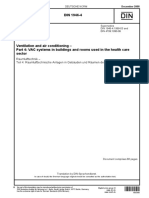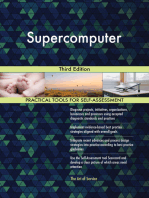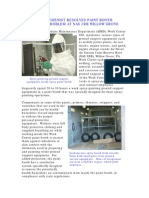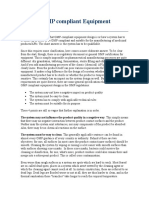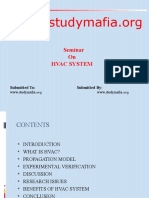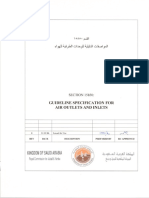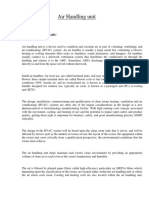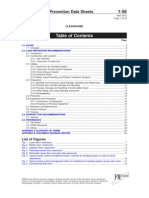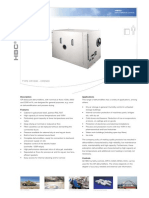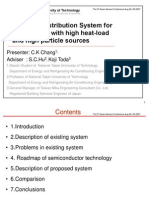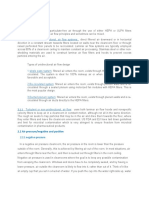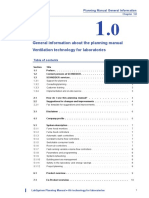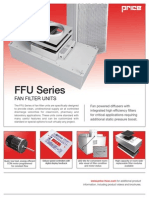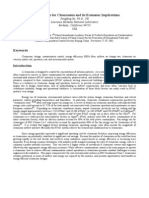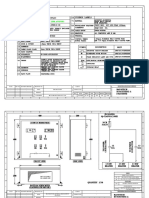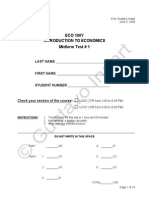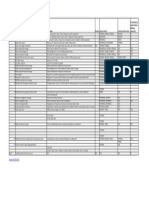Fume Hoods
Fume Hoods
Uploaded by
Abdullah.N FAAliCopyright:
Available Formats
Fume Hoods
Fume Hoods
Uploaded by
Abdullah.N FAAliOriginal Title
Copyright
Available Formats
Share this document
Did you find this document useful?
Is this content inappropriate?
Copyright:
Available Formats
Fume Hoods
Fume Hoods
Uploaded by
Abdullah.N FAAliCopyright:
Available Formats
SECTION 23 3816
FUME HOODS
*************************************************************************************************************
LANL MASTER SPECIFICATION
Word file at http://engstandards.lanl.gov
This template must be edited for each project. In doing so, specifier must add job-specific
requirements. Brackets are used in the text to indicate designer choices or locations where text
must be supplied by the designer. Once the choice is made or text supplied, remove the
brackets. The specifications must also be edited to delete specification requirements for
processes, items, or designs that are not included in the project -- and specifier’s notes such as
these. To seek a variance from requirements in the specifications that are applicable, contact the
Engineering Standards Manual Mechanical POC. Please contact POC with suggestions for
improvement as well.
When assembling a specification package, include applicable specifications from all Divisions,
especially Division 1, General Requirements.
This specification serves as a template. The specification was prepared by an organization
operating under a quality assurance program that meets the requirements of 10 CFR 830
(suitable for ML-1 through ML-4 projects). Implementation of this specification requires
modification to the specification to meet project-specific requirements. Responsibility for
application of this specification to meet project-specific requirements lies with the organization
modifying or implementing the specification. The organization modifying the specification shall
apply a graded approach to quality assurance based on the management level designation of the
project. When this specification is used with nuclear facilities subject to 10 CFR 830, modification
to this specification must be performed by an individual or organization operating under a quality
assurance program that meets the requirements of that CFR.
The specification requirements stated herein are dependent upon specific knowledge of the
system, structure and component’s safety functions and interaction with other systems,
structures, and components. The author of this section shall consider and apply additional safety
requirements based upon knowledge of the system, structure, and component’s specific safety
function as related to the project and facility. These requirements include hood related issues in
nuclear facilities such as exhaust tie-in, primary exhaust, secondary exhaust, hazard control,
plans, required training, Material Control & Accountability, waste management, required records,
etc.
*************************************************************************************************************
PART 1 GENERAL
1.1 SUMMARY
This section establishes the requirements for the specification of laboratory fume hoods.
LANL Project I.D. [__________] Fume Hoods
[Rev. 2, July 29, 2009] 23 3816-1
A. SECTION INCLUDES
Laboratory Fume Hoods, including constant airflow volume open bypass hoods,
variable airflow volume restricted bypass hoods, and special purpose hoods.
Equipment provisions for ADA and ABA compliance are specified where
applicable.
B. PRODUCTS SUPPLIED
1. Based on fume hood design, furnish and install all fume hoods and related
understructures as specified and/or as shown on design drawings.
2. Furnish and deliver all service outlets, accessory fittings, electrical
receptacles and switches, as listed in this specification, equipment
schedules, or as shown on design drawings.
3. Pre-install fittings for attachment to the fume hood superstructure at the
factory.
4. Pre-plumb plumbing fixtures mounted on the fume hood superstructures
per Para 2.3.K. Pre-wire electrical fixtures per Para 2.3.L.
**************************************************************************************************************
*
Edit related sections listed below to meet project requirements associated with the fume hood.
**************************************************************************************************************
*
C. Related Sections
1. Section 01 1116: Work by Owner
2. Section 01 3300: Submittal Procedures
3. Section 01 6000: Product Requirements
4. Section 01 7700: Closeout Procedures
5. Section 13 4800: Sound, Vibration, and Seismic Control
1.2 REFERENCES
Codes, specifications, and standards referred to by number or title form a part of this
specification to the extent required by the following references and others that may exist
in this document. Use codes, specifications, and standards referenced below of the
latest revision at the time of award of subcontract, unless otherwise stated below.
A. 10 CFR 830.122: Nuclear Safety Management Quality Assurance Criteria
B. ASHRAE Standard 110: Method of Testing Performance of Laboratory Fume
Hoods
C. ASTM E84: Standard Test Method for Surface Burning Characteristics of Building
Materials
D. LANL PD 342: Engineering Standards Manual
E. LANL PD-009.004: Receipt Inspection of Items (TA-55)
LANL Project I.D. [__________] Fume Hoods
[Rev. 2, July 29, 2009] 23 3816-2
F. NFPA 45: Standard on Fire Protection for Laboratories Using Chemicals
G. NFPA 255: Standard Method of Test of Surface Burning Characteristics of
Building Materials
H. SEFA 2-1999: Scientific Equipment and Furniture Association - Recommended
Practices for Installation
I. UL 723: Test for Surface Burning Characteristics of Building Materials
1.3 DEFINITIONS AND ACRONYMS
J. Access Opening: Part of a fume hood through which work is performed; entrance;
sash or face opening. Also an opening that allows service access to components
normally hidden behind obstructions, structure, or panels.
K. ABA: Architectural Barriers Act
L. ADA: Americans with Disabilities Act
M. AI: As installed
N. Airfoil: Curved, angular, shaped, or streamlined member at the fume hood
entrance and horizontally oriented across the lower part of the fume hood access
opening. Shaped to provide a smooth airflow into the fume hood interior across
the work surface. Type of fume hood with streamlined members at entrance
opening.
O. AM: As manufactured
P. ANSI: American National Standards Institute
Q. ASHRAE: American Society of Heating, Refrigerating, and Air Conditioning
Engineers
R. Baffle: Panels located across hood interior back wall which control and direct the
pattern of airflow moving through the hood.
S. Bypass: Compensating opening that functions to maintain constant volume fume
hood exhaust, regardless of sash position, and limit the maximum face velocity as
the sash is raised or lowered.
T. Casework: A generic term for base and wall cabinets, display fixtures, and storage
shelves. Generally includes the tops and work surfaces.
U. CAV: Constant Airflow Volume
V. Certificate of Conformance: A supplier’s certification that is traceable to the
shipment, the items, or materials and states that the materials conform in all
respects with the purchase order requirements. This certificate is signed or
otherwise authenticated by the supplier’s authorized representative. The
responsible person within the manufacturing organization signs and authenticates
the CoC and certifies the conformance of all items shipped to purchase-order
requirements.
W. CFR: Code of Federal Regulation
X. CoC: Certificate of Conformance
LANL Project I.D. [__________] Fume Hoods
[Rev. 2, July 29, 2009] 23 3816-3
Y. Combination Sash: A fume hood sash with a framed member that moves vertically
housing two or more horizontally sliding transparent viewing panels.
Z. Damper: Device installed in a duct to control airflow volume.
AA. DBE: Design Basis Earthquake
BB. DOE: Department of Energy
CC. Duct: Round, square, or rectangular tube used to enclose moving air.
DD. Entrance: Front or access opening of fume hood.
EE. Exhaust Collar: Place where exhaust duct connects to fume hood and through
which all exhaust air passes.
FF. Face Velocity: Average velocity of air moving through the fume hood entrance or
access opening and perpendicular to the hood face. Usually expressed in FPM
and measured at the plane of the face opening.
GG. Hood Face: The plane of minimum area at the front portion of a laboratory fume
hood through which air enters when the sash(es) is (are) fully opened, usually in
the same plane as the sash(es) when sash(es) are present.
HH. Horizontal Sash: A fume hood sash with typically two or more framed panels that
slide horizontally across the hood opening.
II. LANL: Los Alamos National Laboratory.
JJ. Make-Up Air: Air needed to replace the air taken from the room by fume hoods
and other air exhausting devices.
KK. NFPA: National Fire Protection Association
LL. Plenum: A chamber used to equalize airflow.
MM. Penetration Portals: Engineered penetrations in the sides of the hood, and/or in
the bottom airfoil that allows for the introduction of additional and/or temporary
wires, hoses, and cords into the hood interior. These portals are fitted with
grommets to prevent abrasion or other damage to items inserted into the portal.
NN. QA: Quality Assurance
OO. Rough-In: Location for point of connection of plumbing, electrical, or mechanical
services within the casework service tunnel/chase. Located within fifteen feet, or
as stated by local codes, whichever is less, of the final fixture location.
PP. Sash: A moveable glazed panel or door set in the hood entrance or access
opening to form a protective shield and to vary the area of the sash opening.
QQ. Sash Opening: Part of the fume hood through which work is performed. The area
of this opening is varied by opening or closing the sash.
RR. SEFA: Scientific Equipment and Furniture Association
SS. Service Fittings: Include oxygen, gas, air, vacuum, and steam cocks; turrets; hot,
cold, and distilled water faucets; remote controlled valves; filter pumps; vacuum
breakers; eye-wash; showerheads; steam cones and steam baths; sinks, cup
sinks, traps, and plaster traps.
LANL Project I.D. [__________] Fume Hoods
[Rev. 2, July 29, 2009] 23 3816-4
TT. Service Fixtures: Include electrical convenience outlet boxes, electrical pedestals,
“C” type conduits, single or duplex VAC or VDC receptacles; switches, variable
voltage units, incandescent bulbs, and fluorescent tubes.
UU. Service Tunnel or Chase: Area in back of or between the backs of base cabinets
and under the working surfaces to allow room for service lines.
VV. SPL: Static Pressure Loss. Measurement of resistance created when air moves
through a duct or hood, usually expressed in inches of water gage.
WW. Standard Hood: Similar to a Constant Airflow Volume Open Bypass Hood. Sash
may be vertical, horizontal, or combination type.
XX. Superstructure: Portion of a fume hood that is supported by the work surface.
YY. UL: Underwriters Laboratories
ZZ. VAV: Variable Airflow Volume
AAA. Vertical Sash: A fume hood sash with one or more framed panels that slide up
and down/vertically across the hood opening to a height required by the operator.
BBB. Work Space: That part of a fume hood interior where apparatus is set up and
fumes are generated. It is normally confined to a space extending from six inches
behind the sash plane to the face of the baffle, and extending from the work
surface up to a plane parallel with the top edge of the access opening.
CCC. Work Surface: The work surface is the area inside the superstructure, from side to
side and from face of baffle to the inside face of the sash.
**************************************************************************************************************
*
Edit articles below to meet project requirements associated with the fume hood. Consult with the
user, IHS-IH Ventilation SME, and the area Industrial Hygienist to ensure the correct fume hood
type is specified.
**************************************************************************************************************
*
1.3 DESIGN AND PERFORMANCE REQUIREMENTS
A. Fume hoods specifically function as ventilated, enclosed work spaces designed to
capture, confine, and exhaust fumes, vapors, and particulate matter produced or
generated within the enclosure.
B. Face velocities of fume hoods are established on the basis of the toxicity or hazard
of the materials used or the operations conducted within the fume hood. [Hoods
will be designed to meet air flow requirements in ACFM (not SCFM) per the
ACGIH Ventilation Manual 26th edition.] A categorization of fume hood types
based on face velocities and materials handled is as follows:
1. Chemical Fume Hoods for areas operating under a Hazard Communication
Plan. The recommended average face velocity is 125 to 150 FPM.
2. Chemical Fume Hoods for areas operating under a Chemical Hygiene
Plan. This includes radioactive activities for which the use of a laboratory
chemical fume hood is acceptable. [Used for most materials and
LANL Project I.D. [__________] Fume Hoods
[Rev. 2, July 29, 2009] 23 3816-5
operations at LANL facilities.] The recommended average face velocity is
80 to 120 FPM. [See ANSI/AIHA Z9.5, Section 3.3.1 (2003)]
C. Provide fume hoods of types listed below with airfoil design to ensure maximum
operating efficiency and containment. Foil sections at the front fascias of the hood
minimize the eddying of air currents at the hood face opening while the rear baffle
system minimizes turbulence in the rear and upper portion of the hood interior.
D. Hood operates on a once through airflow mode with no air recirculation back to
any operating zone. Configure the hood such that no equipment can be placed
within the first six inches inside the hood or placed in a way that will create an
undesirable air current.
E. Provide fume hoods with consistent and safe airflow through the hood face.
Ensure that variations of face velocity do not exceed +20% of the average face
velocity at any designated measuring point for the empty hood.
F. Assure minimal SPL via adequate baffle slot area and exhaust collar configuration.
G. Maximum allowable variation throughout the range of baffle adjustment is +5% for
exhaust CFM, static pressure, and average face velocity at any baffle position.
H. Provide “dead man” features that would automatically return valves, controls, and
switches to a safe position for those valves, controls, and switches affecting
processes that could create hazards due to operator inattention or incapacitation.
I. Ensure that the average illumination of the work surface is 80 foot-candles
minimum. The work surface is defined as the area inside the superstructure, from
side to side and from face of baffle to the inside face of the sash.
J. For fume hood interior materials, use only materials with a flame spread rating of
less than 25 when tested in accordance with NFPA 255 or as otherwise specified.
K. Minimum dimensions: [Specify minimum hood interior dimensions based on
project requirements and fume hood type]. Verify that the hood will pass through a
standard 3 ft x 7 ft doorframe with doorstops or the smallest access way the hood
will need to be moved through.
**************************************************************************************************************
*
Select the type of fume hood required for the specific project. Usually only either CAV-type
hoods or VAV-type hoods will be specified for a project. Additionally, Special or Specific-Purpose
Hoods (e.g. perchloric acid) need to be specified as either CAV- or VAV-type hoods. CAV non-
bypass hoods are not allowed since they do not provide a limit on increases in the face velocity
as the sash is lowered.
*****************************************************************************************************
L. Fume Hood Types
1. Constant Airflow Volume Open Bypass Hood:
a. This type of hood exhausts a constant airflow volume regardless of
the sash position and will automatically bypass air above and below
the sash opening as the sash is lowered.
b. This type of hood permits balancing of the room ventilating system
by maintaining a constant volume of hood exhaust airflow.
LANL Project I.D. [__________] Fume Hoods
[Rev. 2, July 29, 2009] 23 3816-6
c. The upper bypass functions automatically by opening as the sash is
lowered and allows air to enter the hood through a low impedance
grille.
d. The lower bypass, located below the bottom airfoil sill, directs air in
a manner that continuously purges the work surface.
e. The bypass system design must limit face velocity to not more than
three and one-half times the face velocity with the sash fully open.
2. Variable Airflow Volume Restricted Bypass Hood:
a. Hood exhaust airflow volume varies proportionally to the sash
position when used with a hood face velocity controller system
(supplied by others). This type of hood exhausts the maximum
airflow volume when the sash is fully open and the minimum airflow
volume when the sash is completely closed.
b. Use of an independent VAV controller (supplied by others) is
required. Properly installed, the VAV controller adjusts the blower
motor speed or a control damper to compensate for the sash
position in order to maintain a constant face velocity.
c. Coordinate with other VAV controllers in the room air supply system
to ensure proper room balance. Restrict the air bypass per the VAV
manufacturer’s recommendation.
d. Ensure that the bypass system flows at a minimum of 25 CFM/ft2 of
internal hood work surface with the sash closed in order to
maximize containment and achieve proper dilution.
**************************************************************************************************************
*
Only select the types of hoods required for the specific project. If Special or Specific-Purpose
Hoods are not needed, delete this article.
**************************************************************************************************************
*
M. Special or Specific-Purpose Hoods
1. Hoods designed for specific laboratory applications, or hoods that provide
unique features.
a. Perchloric Acid Hood: For safe handling of perchloric acid.
b. Isotope Hood: Designed for handling radioactive isotopes.
c. Combination Hood: Providing both a work surface and walk-in area
in one hood.
d. California Hood: Providing sash openings (usually horizontal) on
multiple sides of the hood work surface for enclosing large or
complex apparatus.
e. Walk-In Hood: Providing sash configuration openings and hood
interiors that extend to the floor for enclosing large or complex
apparatus.
f. Distillation Hood: Providing extra depth and 1/3 to 1/2 height
benches for enclosing tall distillation apparatus.
LANL Project I.D. [__________] Fume Hoods
[Rev. 2, July 29, 2009] 23 3816-7
g. Bench Hood: A fume hood that is located on a work surface.
N. Seismic Design
1. Depending upon the quantity and characteristics of the materials being
contained and the location of the fume hood installation within the LANL
facility, fume hoods must be designed to withstand a DBE.
2. Ensure that the fume hood and its anchorage are in accordance with
applicable performance category requirements stated in the LANL
Engineering Manual, Chapter 5, Structural; Section 13 4800 Sound,
Vibration, and Seismic Control; and other LANL Technical Area-specific
documents.
1.4 SUBMITTALS
A. Submit in accordance with Sections 01 3300, Submittal Procedures and 01 7700,
Closeout Procedures.
B. Product Data
1. Catalog or manufacturer’s data for each fume hood component and
associated equipment specified. Include design features, configurations,
total CFM flow capacity, component dimensions, weight, furnished
accessories, standard materials, construction details, utility and service
requirements, and colors for each type of fume hood.
2. Materials/parts list
C. Shop Drawings
1. Shop drawings indicating component dimensions, tolerances, equipment
locations, large scale plans, elevations, ends, cross sections,
mechanical/electrical rough-in and anchor placement dimensions,
clearances for maintenance and operation, size and location of field
connections, construction details, utility requirements, service run spaces,
and materials used
2. Wiring diagrams
D. Samples
1. Hood interior lining, 6” x 6” sample.
2. Hood enclosure of color selected, 6” x 6” sample.
3. Work surfaces, 6” x 6” sample.
4. Other pre-finished equipment and accessories, 6” x 6” or appropriately
sized sample.
5. Operation signs, placards, and/or instruction plates that will be attached to
hood.
6. Penetration portal sample with grommet [include only when specified].
LANL Project I.D. [__________] Fume Hoods
[Rev. 2, July 29, 2009] 23 3816-8
E. Test Reports and Certificates
1. Provide certification (CoC or other equivalent document) that the fume
hood was designed and factory tested in accordance with ASHRAE
Standard 110.
2. Provide UL Standards for Safety listing for the fume hood superstructure.
3. Provide test reports on each size and type of hood verifying conformance
to specified parameters and regulations. A test report accompanies each
hood as part of the installation and usage package. Include performance
data curves and documentation that fume hoods meet the performance
requirements described in ASHRAE Standard 110 and this specification.
4. Provide certification that the fume hood has been through start-up
procedures and that it is functioning properly.
5. Provide test report on operation of installed fume hood after installation.
6. [TA-55: Refer to PD-009.004, “Receipt Inspection of Items” for additional
requirements.]
F. Manufacturer’s Instructions
1. Manufacturer’s installation and assembly instructions showing the field
installation of parts, components, equipment, and other similar items.
2. Written instructions providing details on proper operation and maintenance.
G. Closeout Submittals
1. Submit in accordance with Sections 01 3300, Submittal Procedures, and
01 7700, Closeout Procedures.
1.5 QUALITY ASSURANCE
A. Use products of a company that has:
1. Manufactured at least 50 fume hoods of the same type and size specified.
[Exceptions to this are allowed for specialty hoods when needed.]
2. Five years or more experience in the manufacture of laboratory fume
hoods, casework, and equipment of type specified.
3. Records of manufacturing facility, testing facility, assembly, and quality
control procedures available for LANL inspection.
4. A QA program meeting the requirements of 10 CFR 830.122.
B. Provide fume hoods with performance conforming to related ANSI, ASHRAE, UL,
and LANL requirements specified in Article 1.2 of this Specification.
1.6 DELIVERY, STORAGE, AND HANDLING
A. Transport, handle, store, and protect product in accordance with the requirements
of Section 01 6000, Product Requirements.
B. Deliver equipment to site in manufacturer’s original, unopened containers and
packaging, with labels clearly indicating equipment name, part numbers,
quantities, and manufacturer.
LANL Project I.D. [__________] Fume Hoods
[Rev. 2, July 29, 2009] 23 3816-9
1.7 WARRANTY
A. The selected manufacturer warrants all products sold to be free from defects in
material and workmanship for a period of one-year minimum, or greater as
negotiated within subcontract, (beginning with date of acceptance). LANL shall
provide notification to the manufacturer’s representative of any defective product
and provide the manufacturer a reasonable opportunity to inspect the goods.
LANL shall not return defective products without written shipping instructions and
authorization from the manufacturer.
1.8 COMMISSIONING
A. Provide labor, materials, and equipment to perform the commissioning process.
PART 2 PRODUCTS
2.1 PRODUCT OPTIONS AND SUBSTITUTIONS
A. Comply with Section 01 2500, Substitution Procedures.
2.2 MANUFACTURERS
A. Listed below are companies with suitable experience specializing in the design
and manufacture of laboratory fume hoods. Other companies may qualify
provided they have suitable experience performing similar work:
1. Fisher Hamilton Incorporated: SafeAire II Fume Hoods [Include Model
number here or on drawings.]
2. Kewaunee Scientific Corporation: Supreme Air Fume Hoods [Include
Model number here or on drawings.]
B. Supply all equipment in accordance with this specification. The offering of a
product differing in materials and construction from this specification requires
written approval from LANL and must demonstrate equivalent or superior
performance. Obtain alternate product approval no less than seven (7) days
before the proposal deadline.
C. LANL reserves the right to reject qualified or alternate proposals and to award
based on product value where such action assures equivalent or greater integrity
of product.
2.3 MANUFACTURED UNITS
A. Fume Hood Superstructure Frame:
1. A freestanding rigid frame structure of steel angle provided to support
exterior and interior liner and baffle panels.
2. Exterior steel panels can be removed without disassembly of the frame
structure and inner liner panels.
B. Fume Hood Interior Walls:
1. Provide double walled ends that maximize interior working area. The area
between the double walled ends houses the remote control valves, sash
counterbalance weights, electrical receptacles, and wiring.
LANL Project I.D. [__________] Fume Hoods
[Rev. 2, July 29, 2009] 23 3816-10
2. To allow for plumbing and electrical system maintenance and
replacements, provide removable interior liner access panels that can be
removed without disassembly of the superstructure frame and exterior steel
panels.
3. Contour the front vertical fascia section at the front leading edge to provide
a streamlined hood air entrance section and ensure smooth even flow of air
into the hood. The vertical fascias house the required service controls,
electrical switches and receptacles.
4. Provide hood interior end panels and sash track flush with the fascia to
prevent eddy currents and back flow of air.
C. Fume Hood Exteriors:
1. Construct from cold rolled steel with component parts screwed together to
allow removal of the end panels, front end and top fascia pieces, and airfoil
strips for replacement or to afford access to the plumbing lines, service
fittings, and electrical components.
2. Weld spacers or reinforcements to the exterior parts as required.
D. Fume Hood Finish:
1. Pre-treat steel component parts after welding/fabrication, but before final
assembly, to provide a uniform fine-grained crystalline phosphate surface
that will enhance both the final finish bond and final finish resistance to
humidity, corrosion, and corrosive chemicals.
2. Physically and chemically clean the steel by degreasing and washing with
an alkaline cleaner then follow with a complete metallic phosphate solution
spray treatment. After the phosphate treatment, completely dry the steel.
3. Apply a corrosion-resistant primer base coat using an electro-deposition
dip procedure to guarantee complete paint coverage. Powder-coat or
solvent-based spray paints are unacceptable for the initial base paint coat.
Cure the coating by baking at elevated temperatures to provide maximum
properties of corrosion and wear resistance.
4. Provide an acid, alkali, and solvent resistant final topcoat finish on both
exterior and interior surfaces of all parts.
E. Fume Hood Airfoil:
1. Provide an integral airfoil, streamlined similar to the sides, at the bottom of
the hood opening. Provide a nominal 1” open space between the airfoil
and the top front edge of the work surface to direct an airflow stream
across the work surface, to prevent the back flow of air, and to purge the
work surface airspace of contaminants. Extend the airfoil back under the
sash, so that the sash does not close the 1-inch opening.
2. Fabricate the airfoil from 12-gauge-minimum steel to provide rigidity and to
resist denting and flexing.
3. For walk-in hoods, provide a stop located at the bottom of the sash track
that will ensure a nominal 1-inch opening between the bottom of the sash
and the floor.
LANL Project I.D. [__________] Fume Hoods
[Rev. 2, July 29, 2009] 23 3816-11
F. Fume Hood Top Panel:
1. The top front panel of the hood may have an integral 1/4” thick laminated
safety float glass or polycarbonate vision panel [choose one] located
directly above the sash opening and in such a manner as to allow viewing
the top interior portion of the hood without having the operator stoop or
place their face inside the hood.
2. For Constant Airflow Volume Open Bypass Hoods:
a. Provide an integral grille that will bypass airflow at the top of the
sash opening. The bypass will operate passively and will not rely
on mechanical or electrical means to perform its function.
**************************************************************************************************************
*
Baffles may be fixed or adjustable depending on system specification and intended application.
Consult with the user and the area Industrial Hygienist to determine the type of baffle needed. If
adjustable baffles are needed, then direct or remote operation will need to be defined.
**************************************************************************************************************
*
G. Fume Hood Baffles:
1. Provide a baffle system with three horizontal slots designed to facilitate
airflow distribution through the hood. Position horizontal slots at the low,
mid, and upper sections of the hood interior back wall.
2. Provide baffles made of the same material as the fume hood liner.
3. Provide removable baffles to facility cleaning.
**************************************************************************************************************
*
Select one of the following types of baffles.
**************************************************************************************************************
*
4. Fixed Baffle: Provide acid-resistant labeling indicating the specific
contaminant properties that the baffle system is configured for (i.e. lighter
than air or heavier than air gases or fumes, high heat generation
processes, or general conditions).
5. Adjustable Baffle: Provide adjustability that will accommodate the airflow
management requirements for various contaminant properties. As a
minimum, provide adjustability for the top and bottom slots. Provide acid-
resistant labeling indicating proper baffle adjustment position for various
contaminant properties.
6. Remote Adjustable Baffle: Provide adjustability that will accommodate the
airflow management requirements for various contaminant properties. As a
minimum, provide adjustability for the top and bottom slots. Provide a
single-point remote baffle adjustment device that will allow convenient and
prompt adjustment from either the hood exterior or from no further than 6”
into the hood. Locate the baffle adjustment device such that it will not
require the entry of the operator’s head into the hood and so that it will be
LANL Project I.D. [__________] Fume Hoods
[Rev. 2, July 29, 2009] 23 3816-12
accessible by both able bodied and wheelchair bound operators. Provide
acid-resistant labeling indicating proper baffle adjustment position for
various contaminant properties.
H. Fume Hood Duct Collar:
1. Provide polyethylene or stainless steel bell-mouthed duct collar(s) located
in the hood plenum chamber. [Always provide stainless steel duct collars
for fume hoods with stainless steel liners.]
**************************************************************************************************************
* Fluorescent light fixtures shall be provided for all fume hoods unless incandescent light fixtures
are needed for a specific reason. Verify with the user if specific light quality is required for an
application. The only exception to this is perchloric acid fume hoods which require the use of
vapor proof incandescent light fixtures. Fume hoods installed in an explosives area may also
require the use of explosion-proof incandescent light fixtures.
**************************************************************************************************************
*
I. Fume Hood Lighting:
1. Fluorescent Light Fixtures:
a. Ensure that all fixtures are UL approved and labeled.
b. Provide fluorescent lights with T-8 bulbs.
c. Provide electronic ballast for fluorescent light fixtures.
d. Isolate the fluorescent light fixtures from the hood interior by a 1/4”
thick tempered glass, safety glass, or polycarbonate [choose one]
panel sealed from the hood cavity. Ensure that bulb replacement is
accomplished from the hood exterior only.
e. Provide fluorescent light fixtures in the top of the hood. Locate
lighting power switch so that it is operable by both able bodied and
wheelchair operators. The minimum illumination at the work
surface is to be 80 foot-candles.
2. Incandescent Light Fixtures:
a. Ensure that all fixtures are UL approved and labeled.
b. Provide incandescent light fixtures with vapor proof lamps and
shatterproof globes.
c. Provide incandescent light fixtures in the top of the hood. Locate
lighting power switch so that it is operable by both able bodied and
wheelchair operators. The minimum illumination of the work
surface is to be 80 foot-candles.
d. Provide explosion proof lighting when specified.
J. Fume Hood Sash
1. Provide a vertical, horizontal, or combination sash as specified.
LANL Project I.D. [__________] Fume Hoods
[Rev. 2, July 29, 2009] 23 3816-13
2. Produce sash frame from 18-gauge steel with mitered and welded corners
ground smooth to provide a complete unit with no visible joints. Use
replaceable plastic guides for the sash frames that will operate in stainless
steel sash guides to prevent metal-to-metal contact.
3. Provide sash tracks set flush with the interior liner panels to minimize
turbulence.
4. Produce the sash glass from 1/4” laminated safety float glass or
polycarbonate panels. [Use polycarbonate panels on fume hoods used for
hydrofluoric acid operations or for other operations where this is a better
choice than glass.]
5. Set glass/polycarbonate panels into deep form extruded polyvinyl chloride,
or equivalent, channels internally interlocked with the outer member sealing
and retaining the glazing.
6. Provide rubber bumper stops for the sash to open and close against.
7. Counterbalance System:
a. Counter balance up/down moving (vertical or combination) sashes
with a weight and cable/chain system designed to prevent sash
tilting and binding during operation. Permit one finger operation at
any point on the sash pull.
b. Ensure that the system will hold the sash at any position without
creep and will prevent sash drop in the event of cable/chain failure.
c. Provide stainless steel sash cables operating on ball bearing
pulleys/sheaves. Provide stainless steel sash chains operating on
ball bearing sprockets.
d. Do not use spring type counterbalances.
K. Fume Hood Plumbing Services
1. Provide all plumbing fittings factory installed and piped between the valve,
outlet, and service inlet. Provide inlet piping with a labeled single-point
connection located on the hood exterior for each valve and route to a point
that will best suit rough-in locations shown on the design drawings.
2. Provide remote controlled valves, as selected, located within the end
panels and actuated by chrome plated or plastic [choose one] 4-armed
handles attached to brass extension rods that project through control
panels located in the hood vertical fascias. Furnish the valve handles with
color-coded and labeled service indicators.
3. Locate all services so that they are reachable by both able bodied and
wheelchair bound operators.
4. For interior fittings supplying gases and water, provide nylon panel flanges
and nylon angle serrated hose connectors, color-coded to match services.
For distilled water interior fittings, provide tin lined bronze panel flanges
and angle serrated hose connectors with white color-coding. For steam
interior fittings, provide cast bronze flanges and angle serrated hose
connectors with a chemical resistant metallic bronze finish. Provide water
goosenecks in cast bronze with a chemical resistant metallic bronze finish.
LANL Project I.D. [__________] Fume Hoods
[Rev. 2, July 29, 2009] 23 3816-14
L. Fume Hood Electrical Services
1. Pre-wire the hood superstructure and provide a UL label certifying
acceptable wire gauge, connections, fixtures, and wire color coding.
2. Provide 120 V, specification grade, 20 amp, duplex GFCI receptacles
mounted on the vertical fascia. [Additional requirements may apply if
outlets are to be located within the interior of the fume hood.]
3. Locate all frequently operated services so that they are reachable by both
able bodied and wheelchair bound operators.
**************************************************************************************************************
* Delete this article if an Isotope Hood or a Perchloric Acid Hood is specified since the work
surface is an integral part of the hood interior for those types of hoods.
**************************************************************************************************************
*
M. Hood Work Surface
1. Epoxy Resin:
a. Use molded epoxy resin made in the form of a watertight pan of
3/8” minimum depth with a 6” wide safety ledge across the front
edge.
b. When water service is supplied, provide a cup drain flush with the
recessed portion of the work surface.
2. Stainless Steel:
a. Use 14-gauge, type 304 stainless steel with a No. 4 finish made in
the form of a watertight pan of 1/2” minimum depth with a 6” wide
safety ledge across the front edge.
b. When water service is supplied, provide a cup drain flush with the
recessed portion of the work surface.
c. Reinforce to support a uniform loading of 200 psf minimum.
**************************************************************************************************************
* Choose the type of liner based on the specific requirements of the project. For most
applications, the Epoxy Resin liner should be used. The Cement Board liner is only to be
specified when it is the only acceptable material from a chemical compatibility standpoint. If a
Stainless Steel liner is needed, look at specifying an Isotope Hood since this type of fume hood
has coved corners to make it easier to clean. Delete this article if an Isotope Hood or a
Perchloric Acid Hood is specified since the liner is an integral part of the hood interior for those
types of hoods.
**************************************************************************************************************
*
N. Fume Hood Liners
1. Epoxy Resin:
a. Use 1/4” thick sheets with maximum flame spread of 6.2 per ASTM
E84.
LANL Project I.D. [__________] Fume Hoods
[Rev. 2, July 29, 2009] 23 3816-15
b. Fasten epoxy resin liner panels using stainless steel screws with
plastic covered heads.
c. Fiberglass reinforced plastics or polyesters are not acceptable
substitute liner materials for epoxy resin.
2. Reinforced Polyester Lining:
a. Use 1/4” thick fiberglass reinforced polyester sheet with smooth
finish, maximum flame spread of 15 per UL 723 and ASTM E84.
b. Fasten reinforced polyester liner panels using stainless steel
screws with plastic covered heads.
3. Cement Board:
a. Use 1/4" thick, dense, monolithic sheet with a chemically resistant,
inorganic, non-asbestos mixture of fiber cement. Maximum flame
spread of 0 per ASTM E84.
b. Coat surfaces exposed to the hood interior with a white epoxy
finish.
c. Fasten cement board liner panels using non-corrosive fasteners.
4. Reinforced Phenolic Resin:
a. Use 1/4” thick sheet made from a compression molded cellulose
fiber reinforced phenolic resin core with integrally cured melamine
surfaces.
b. Fasten reinforced phenolic resin liner panels using stainless steel
screws with plastic covered heads.
5. Stainless Steel
a. 16-gauge, type 304 stainless steel with a No. 4 finish fastened in
place with stainless steel screws.
**************************************************************************************************************
* Airflow Indicators are only to be specified for CAV-type fume hoods. VAV-type fume hoods will
have a face velocity indicator provided by the fume hood controls vendor. Only specify a fume
hood manufacturer’s face velocity indicating device after all of the limitations of that device have
been evaluated and deemed acceptable. Consult with the Industrial Hygiene Ventilation SME for
additional information. For most fume hood installations a pressure differential gage (e.g.,
Magnehelic gage with the appropriate range) measuring the static pressure in the exhaust duct
just downstream of the fume hood connection but upstream of the first damper is sufficient. See
LANL Standard Drawings and Details, Drawing ST-D3040-1 for details. When additional visual
(light) and/or audible alarms are needed then a Photohelic gage can be used as basis of the
monitoring alarm. These type of gages need to be specified in the system design not here in the
fume hood specification.
**************************************************************************************************************
*
O. Fume Hood Monitors and Alarms
1. Provide a safety monitoring and alarm system that monitors:
LANL Project I.D. [__________] Fume Hoods
[Rev. 2, July 29, 2009] 23 3816-16
a. Hood face velocity and provides audible and visual alarms when
face velocity drops below or rises above IHS-IH specified face
velocities. [See LIHSM Chapter 39.]
b. The audible alarm is mutable via a panel mounted manually
operated switch that is accessible by both able bodied and
wheelchair bound operators. The visual alarm continues to flash as
long as the alarm condition exists.
P. Fume Hood Special Requirements [Include any special requirements not specified
elsewhere in this specification. Examples: 1) Penetration portals needed through
the side panels or through the bottom airfoil of the hood. Specify the number,
location, size, and if closures are needed, etc. Be sure to provide openings with
grommets to protect cords and hoses from abrasion. 2) Sliding Safety Shield.
Specify material, thickness, etc. This type of shield is usually specified for hoods
used for highly energetic processes (e.g. explosives and other dynamic
operations)]
**************************************************************************************************************
* Delete this article unless a perchloric acid hood is required. Consult with the area Industrial
Hygienist and NFPA 45 for guidance.
**************************************************************************************************************
*
Perchloric Acid Hoods
1. A fume hood equipped with wash down washers, integral work surfaces,
coved corners, and non-organic lining materials.
2. Fabricate hood interior lining, including end panel and back panel, from 16-
gauge, type 316 stainless steel with a No. 4 finish. Fabricate the inside
back and end panels in a seamless, welded, wrap around design that is
welded to the work surface. Fabricate all vertical and horizontal corners
and seamless joints between inside back, end panels, and work surfaces
with 1/2” internal radius. Grind all welds flush and blend to a No. 4 finish.
Reinforce the entire stainless steel hood interior to provide a completely
rigid, welded together, self-supporting assembly. Provide the hood end
liners without access openings.
3. Fabricate hood work surface from 14-gauge, type 316 stainless steel with a
No. 4 finish in the form of a watertight pan 1/2” deep with a 6” wide safety
ledge at the front edge and an integral, continuous trough sink across the
full width at the back of the work surface. Provide, within the trough sink,
two 1-1/2” waste outlets to drain wash down system water. Reinforce the
work surface to support a uniform maximum loading of 200 pounds per
square foot.
4. Fabricate baffles and top panel from 16 gauge type 316 stainless steel with
a No. 4 finish. Fasten the baffle to the hood interior with stainless steel
screws. Provide easily removable baffles to facilitate cleaning of the
baffles and the area behind the baffles.
LANL Project I.D. [__________] Fume Hoods
[Rev. 2, July 29, 2009] 23 3816-17
5. Provide a wash down system that includes a remote controlled perforated
spray pipe to wash down rear surface of the hood interior behind the
baffles and a remote controlled water fitting.
6. Provide the hood with a label stating “For Perchloric Acid Operations Only”
affixed to the front of the fume hood above the sash opening.
**************************************************************************************************************
* Delete this article unless an isotope hood is needed. An isotope hood should be considered for
any operation that requires the hood interior to be easily cleaned.
**************************************************************************************************************
*
Q. Isotope Hoods
1. A fume hood with integral work surface, coved corners, linings
impermeable to radioactive materials, and structure reinforced to support
lead shielding bricks.
2. Provide interior construction that prevents radioactive material buildup and
allows complete cleaning.
3. Fabricate hood interior lining, including end panel and back panel, from 14-
gauge, type 304 or 316 stainless steel with a No. 4 finish. Fabricate the
inside back and end panels in a seamless, welded, wrap around design
that is welded to the work surface. Fabricate all vertical and horizontal
corners and seamless joints between inside back, end panels, and work
surfaces with 1/2” internal radius. Grind all welds flush and blend to a No.
4 finish. Reinforce the entire stainless steel hood interior to provide a
completely rigid, welded together, self-supporting assembly. Provide the
hood end liners without access openings.
4. Fabricate hood work surface from 14 gauge, type 304 or 316 stainless
steel with a No. 4 finish in the form of a watertight pan 1/2” deep with a 6”
wide safety ledge at the front edge. Reinforce the work surface to support
a uniform maximum loading of 200 pounds per square foot.
5. When water service is supplied, provide a cup drain flush with the recessed
portion of the work surface.
6. Fabricate baffles and top panel from 16 gauge, type 304 or 316 stainless
steel with a No. 4 finish. Fasten the baffle to the hood interior with
stainless steel screws. Provide easily removable baffles to facilitate
cleaning of the baffles and the area behind the baffles.
2.4 SOURCE QUALITY CONTROL
A. Containment Performance Testing
1. Purpose: To pre-qualify the performance of the bidder’s laboratory fume
hood before award of subcontract or before acceptance of the hood after
award of subcontract.
LANL Project I.D. [__________] Fume Hoods
[Rev. 2, July 29, 2009] 23 3816-18
2. Test Method
a. Conduct pre-qualification testing of fume hoods per ASHRAE
Standard 110 at the bidder’s fume hood test facility. Conduct tests
in the ASHRAE defined AM mode by personnel cognizant of the
recommended test procedures. Refer to ASHRAE Standard 110 for
specific requirements, procedures, and qualification criteria.
b. Use the following tests to judge the performance of the fume hood:
i. Face Velocity Test
ii. Flow Visualization Test
iii. Large Volume Flow Test
iv. Tracer Gas Test
v. Sash Movement Test
PART 3 EXECUTION
3.1 EXAMINATION
A. Certify to LANL that building conditions are conducive to the installation of a
finished goods product, including all critical dimensions.
B. Inspect areas and conditions, with installer present, for compliance with
requirements for installation tolerances and other conditions affecting the
performance of the fume hood. Ensure the area is free of undesirable air currents
(i.e., > 40 fpm vertical and horizontal cross drafts with respect to the hood face)
that would adversely affect hood performance.
C. Inspect utility rough-ins to verify actual locations of connections prior to beginning
installation.
D. Check and verify that no irregularities exist that would affect quality of execution of
work specified.
E. Formally notify LANL in writing if existing conditions will affect acceptable results.
3.2 INSTALLATION
A. Reference SEFA 2-1999 for fume hood installation information and guidelines.
B. Arrange installation of fume hoods to provide access space for service and
maintenance.
C. Coordinate work with the schedule and requirements of other work being
performed in the area at the same time both with regard to mechanical and
electrical connections to and in the fume hoods and the general construction work.
D. Coordinate work between LANL and the manufacturer/subcontractor per Section
01 1116, Work by Owner. Final plumbing and electrical connections are the
responsibility of those subcontractors fulfilling requirements of sections in those
Divisions.
LANL Project I.D. [__________] Fume Hoods
[Rev. 2, July 29, 2009] 23 3816-19
E. Assemble and install fume hoods in accordance with approved shop drawings and
manufacturer’s installation instructions. Ensure that fume hood assembly and
installation are performed by or supervised by fume hood manufacturer personnel.
F. Install fume hoods, plumb, level, square, with no distortion, and securely anchored
to building and adjacent furniture in proper location.
G. Install fume hood equipment to provide maximum safety and continuity of
operation in the event of seismic activity per requirements defined in Para 1.4.N.
H. Secure work surfaces to casework and equipment components with material and
procedures recommended by the manufacturer.
I. Install accessories and fittings in accordance with manufacturer’s
recommendations.
3.3 FIELD QUALITY CONTROL
A. Site Tests, Inspection
1. Arrange for a factory authorized service representative to inspect the field
assembly and installation of the fume hoods, including piping, ductwork,
and electrical connections; and to prepare a written report on findings with
recommended corrective actions.
2. Conduct AI testing of fume hoods at LANL per ASHRAE Standard 110.
Perform tests in field to verify proper operation of the fume hood before
placing into service. Perform tests only after installation is complete, the
building make-up air system is in operation, the building ventilation system
has been balanced, all connections have been made, the doors and
windows are in normal operating position, all other hoods and exhaust
devices are operating at designed conditions, and written verification has
been submitted that the aforementioned conditions have been met.
3. Modifications to the hood, placement of new large equipment, or equipment
that creates heat or mechanical air disturbances that would alter the airflow
characteristics within the hood require retesting for confinement capability
before the hood is placed in service.
4. Correct any discrepancies, errant processes, or unsafe conditions
disclosed by these tests before request of test procedures.
5. Project substantial completion shall be withheld until all required fume hood
certification letters, tests, and reports have been submitted and approved.
B. Manufacturers’ Field Services
1. Ensure that the fume hood manufacturer field tests 100% of the installed
units per ASHRAE 110 to a control level of Al 0.01 ppm or better.
3.4 ADJUSTING
A. Adjust sash, baffles, fixtures, accessories, and other moving or operating parts for
proper function and operation.
B. Repair or remove and replace defective work as directed by LANL.
C. Reference Section 01 7700, Closeout Procedures, for additional detail.
LANL Project I.D. [__________] Fume Hoods
[Rev. 2, July 29, 2009] 23 3816-20
3.5 CLEANING
A. Remove all debris, dirt, packing materials, and rubbish accumulated as a result of
the installation of the fume hoods to an on-site container provided by LANL or
others, leaving the premises clean and orderly.
B. Clean fume hood interior and exterior to remove foreign material and construction
dirt.
C. Reference Section 01 7700, Closeout Procedures for additional detail.
3.6 DEMONSTRATION
A. Provide written and oral instructions that detail proper operation and maintenance.
B. Reference Section 01 7700, Closeout Procedures for additional detail.
3.7 PROTECTION
A. Provide necessary protective measures to prevent casework and equipment from
being exposed to and damaged from other construction activity.
B. Advise LANL of procedures and precautions for protection of material, installed
laboratory casework, and fixtures from damage by work of other trades.
END OF SECTION
*****************************************************************
Do not delete the following reference information.
*****************************************************************
FOR LANL USE ONLY
This project specification is based on LANL Master Specification 23 3816 Rev. 2, dated July 29,
2009.
LANL Project I.D. [__________] Fume Hoods
[Rev. 2, July 29, 2009] 23 3816-21
You might also like
- DIN 1946-4 Engl. Dez. 2008Document68 pagesDIN 1946-4 Engl. Dez. 2008Lệ HoaNo ratings yet
- Caleffi Ice Snow System Installation ManualDocument21 pagesCaleffi Ice Snow System Installation Manuale-ComfortUSANo ratings yet
- EHS Washington Fume Hood Placement 2009Document15 pagesEHS Washington Fume Hood Placement 2009mustafa matter02100% (1)
- 093 Paint Booth VentDocument3 pages093 Paint Booth VentFajar Hadi CrisnamurtiNo ratings yet
- D B I C: Clean Air Technology, Inc. Esigns, Uilds and Nstalls LeanroomsDocument2 pagesD B I C: Clean Air Technology, Inc. Esigns, Uilds and Nstalls LeanroomsRajeshNo ratings yet
- What Is GMP Compliant Equipment DesignDocument3 pagesWhat Is GMP Compliant Equipment DesignLaura TarazonaNo ratings yet
- TSI PANDA 341 User ManualDocument38 pagesTSI PANDA 341 User ManualHernan RomeroNo ratings yet
- Mca HVAC SystemDocument12 pagesMca HVAC SystemPrem Chandu BallemNo ratings yet
- Prihoda Recycled Fabric Duct SpecificationDocument5 pagesPrihoda Recycled Fabric Duct SpecificationaverentzNo ratings yet
- CTA ING NVB 111 BDocument32 pagesCTA ING NVB 111 BnmtinhNo ratings yet
- Ansi Ashrae 62Document11 pagesAnsi Ashrae 62Jorge Antonio Díaz NambrardNo ratings yet
- Basis of Hvac Design German Pharma Indusrie ProjectDocument6 pagesBasis of Hvac Design German Pharma Indusrie ProjectclaudiojrriveraNo ratings yet
- SECTION 15850 Air Outlets and Inlets Rev 0Document31 pagesSECTION 15850 Air Outlets and Inlets Rev 0Munir RasheedNo ratings yet
- 1 Clivet Chiller Product Lineup BrochureDocument2 pages1 Clivet Chiller Product Lineup BrochureTony NguyenNo ratings yet
- Eurovent Air Filters GuidebookDocument28 pagesEurovent Air Filters GuidebookandreNo ratings yet
- Duct Sealing in Large BuildingsDocument31 pagesDuct Sealing in Large BuildingsShiyamraj ThamodharanNo ratings yet
- HTTP WWW - Bryair.com Manuals Man07Document17 pagesHTTP WWW - Bryair.com Manuals Man07rama deviNo ratings yet
- Fume Hood Canada Government Design SpecificationsDocument100 pagesFume Hood Canada Government Design Specificationscgoveia3No ratings yet
- Index PDFDocument7 pagesIndex PDFganesh gundNo ratings yet
- Robatherm All in One EngDocument12 pagesRobatherm All in One Engdimchien100% (1)
- Control Valve Selection GuideDocument16 pagesControl Valve Selection Guidemarsha.fsdNo ratings yet
- I HtgMKTGLiteraturePDFsModine7-115 0Document24 pagesI HtgMKTGLiteraturePDFsModine7-115 0huron11100% (1)
- Federal Standard 209E Airborne Particulate Cleanliness Classes in Cleanrooms and Clean ZonesDocument56 pagesFederal Standard 209E Airborne Particulate Cleanliness Classes in Cleanrooms and Clean ZonesHassan HoudoudNo ratings yet
- GMP Annex 1 Revision 2008Document11 pagesGMP Annex 1 Revision 2008zombiecorpNo ratings yet
- Clean Room TechnologyDocument45 pagesClean Room TechnologyPradeep SumanNo ratings yet
- BS en 15727-2010Document18 pagesBS en 15727-2010Nibin BabyNo ratings yet
- Air Handling UnitDocument3 pagesAir Handling UnitPrince Moni100% (2)
- Tsi Panda 341 User ManualDocument37 pagesTsi Panda 341 User Manuala k bNo ratings yet
- Fume Hood GuideDocument15 pagesFume Hood Guideabaddown100% (1)
- Clean RoomDocument24 pagesClean RoomTran Thanh Tuan100% (1)
- 05 PPT System Effects 06Document60 pages05 PPT System Effects 06Anonymous 6lLH9TMOlNo ratings yet
- TYPE CR1500 - CR2500: Description ApplicationsDocument2 pagesTYPE CR1500 - CR2500: Description ApplicationsXIN NIUNIUNo ratings yet
- Fan Dry Coil Unit System For Acc 5th Rev.cDocument19 pagesFan Dry Coil Unit System For Acc 5th Rev.candy5310No ratings yet
- Fume Hood Calibration, Face Velocity Testing: Application NoteDocument2 pagesFume Hood Calibration, Face Velocity Testing: Application NoteIván Acosta MárquezNo ratings yet
- Ventilation WriteUp PDFDocument6 pagesVentilation WriteUp PDFJordan Rock100% (1)
- Handbook Chapter19 ChilledBeamsDocument50 pagesHandbook Chapter19 ChilledBeamsJoao SousaNo ratings yet
- Health Care Standards and GuidelinesDocument34 pagesHealth Care Standards and GuidelinesMAGDY KAMEL100% (1)
- 248083206-1 R3 (Op Man LMS XChange v1.5) A4Document60 pages248083206-1 R3 (Op Man LMS XChange v1.5) A4Eszter DevecserNo ratings yet
- Air Filter ReportDocument48 pagesAir Filter ReportKrishna KumarNo ratings yet
- FumehoodDocument20 pagesFumehoodfelipecam5No ratings yet
- Retrofitting of Existing Buildings To Achieve Better Energy Efficiency in Commercial BuildingDocument23 pagesRetrofitting of Existing Buildings To Achieve Better Energy Efficiency in Commercial BuildingmrccahmedNo ratings yet
- 7-150.3 Catalog, Direct-Fired Make-Up Air Units, MDB MRBDocument40 pages7-150.3 Catalog, Direct-Fired Make-Up Air Units, MDB MRBMayur Patel100% (1)
- Basic Requirements For Clean RoomDocument6 pagesBasic Requirements For Clean Roomsamuel debebeNo ratings yet
- Jet Nozzle New CatalogueDocument3 pagesJet Nozzle New Cataloguedikran330% (1)
- General Information About The Planning Manual Ventilation Technology For LaboratoriesDocument10 pagesGeneral Information About The Planning Manual Ventilation Technology For LaboratoriesRenato MendesNo ratings yet
- ASHRAE 15 - Reducing Toxic Leaks in HVAC Mechanical Equipment RoomsDocument4 pagesASHRAE 15 - Reducing Toxic Leaks in HVAC Mechanical Equipment Roomspsn_kylmNo ratings yet
- Europass CVDocument2 pagesEuropass CVshamimhd704No ratings yet
- FFUDocument14 pagesFFUNathan VoNo ratings yet
- Is Iso 9170 1 2008Document28 pagesIs Iso 9170 1 2008dekraguljNo ratings yet
- Airflow Design For Clean Rooms and Its Economic ImplicationsDocument7 pagesAirflow Design For Clean Rooms and Its Economic ImplicationsDanny D.No ratings yet
- Fume HoodsDocument18 pagesFume HoodsRezaNo ratings yet
- LANL Project I.D. ( - ) Indoor Central-Station Air-Handling Units (Rev. 0, May 19, 2010) 23 7300 - 1Document27 pagesLANL Project I.D. ( - ) Indoor Central-Station Air-Handling Units (Rev. 0, May 19, 2010) 23 7300 - 1Abdullah.N FAAliNo ratings yet
- Computer-Room Air ConditionersDocument19 pagesComputer-Room Air ConditionersAbdullah.N FAAliNo ratings yet
- Project Standard Specification: Metal Ducts 15815 - Page 1/12Document12 pagesProject Standard Specification: Metal Ducts 15815 - Page 1/12adel rihanaNo ratings yet
- Project Standard Specification: Packaged Terminal Air-Conditioning Units 15784 - Page 1/5Document5 pagesProject Standard Specification: Packaged Terminal Air-Conditioning Units 15784 - Page 1/5adel rihanaNo ratings yet
- 238219-Fan-Coil UnitsDocument9 pages238219-Fan-Coil UnitsMohamed SokarNo ratings yet
- Spiral Oval Duct Sizing ChartDocument1 pageSpiral Oval Duct Sizing ChartAbdullah.N FAAliNo ratings yet
- PB1303 B1FrameDocument2 pagesPB1303 B1FrameAbdullah.N FAAliNo ratings yet
- PB1304 A-4FrameDocument2 pagesPB1304 A-4FrameAbdullah.N FAAliNo ratings yet
- Refrigerant Oil ChartDocument1 pageRefrigerant Oil ChartAbdullah.N FAAli100% (1)
- GehepaDocument3 pagesGehepaAbdullah.N FAAliNo ratings yet
- Project Reference - Hybrid Operating Theatre, Hoglandssjukhuset, Esjo, SwedenDocument7 pagesProject Reference - Hybrid Operating Theatre, Hoglandssjukhuset, Esjo, SwedenAbdullah.N FAAliNo ratings yet
- Laminar Flow AppDocument6 pagesLaminar Flow AppAbdullah.N FAAliNo ratings yet
- 027 Bded 01 A 1644 BDDocument4 pages027 Bded 01 A 1644 BDAbdullah.N FAAliNo ratings yet
- John ColquhounDocument15 pagesJohn ColquhounAbdullah.N FAAliNo ratings yet
- MervDocument1 pageMervAbdullah.N FAAliNo ratings yet
- I - Rectangular Ducts: II - Rectangular Ducts WeldedDocument32 pagesI - Rectangular Ducts: II - Rectangular Ducts WeldedAbdullah.N FAAliNo ratings yet
- SWRSC SDL480XDocument2 pagesSWRSC SDL480XAbdullah.N FAAliNo ratings yet
- FG - Multi-DENCO® Technical Data - Specification-Technical - UNDocument44 pagesFG - Multi-DENCO® Technical Data - Specification-Technical - UNAbdullah.N FAAliNo ratings yet
- The Rates of Outdoor Make Up Air in The Table Below Can Be Used As A Guideline in Design of Ventilation SystemsDocument8 pagesThe Rates of Outdoor Make Up Air in The Table Below Can Be Used As A Guideline in Design of Ventilation SystemsAbdullah.N FAAliNo ratings yet
- Quirofanos en 15Document6 pagesQuirofanos en 15Abdullah.N FAAliNo ratings yet
- Copper Piping CostingDocument9 pagesCopper Piping CostingAbdullah.N FAAliNo ratings yet
- AXC 1000-10/20°-4 (11,00 KW) S V3: Item NoDocument3 pagesAXC 1000-10/20°-4 (11,00 KW) S V3: Item NoAbdullah.N FAAliNo ratings yet
- Rayotech Heater STARTER PANELSDocument4 pagesRayotech Heater STARTER PANELSAbdullah.N FAAliNo ratings yet
- Mechanical POCDocument38 pagesMechanical POCAbdullah.N FAAliNo ratings yet
- An VidaDocument51 pagesAn VidaAbdullah.N FAAliNo ratings yet
- HVAC Water TreatmentDocument6 pagesHVAC Water TreatmentAbdullah.N FAAliNo ratings yet
- Computer-Room Air ConditionersDocument19 pagesComputer-Room Air ConditionersAbdullah.N FAAliNo ratings yet
- LANL Project I.D. ( - ) Indoor Central-Station Air-Handling Units (Rev. 0, May 19, 2010) 23 7300 - 1Document27 pagesLANL Project I.D. ( - ) Indoor Central-Station Air-Handling Units (Rev. 0, May 19, 2010) 23 7300 - 1Abdullah.N FAAliNo ratings yet
- Chiller Selection MethodDocument9 pagesChiller Selection MethodAbdullah.N FAAliNo ratings yet
- 23 4133R1Document21 pages23 4133R1Abdullah.N FAAliNo ratings yet
- Testimg Adjusting and Balancing For HVACDocument14 pagesTestimg Adjusting and Balancing For HVACAbdullah.N FAAliNo ratings yet
- Unit HeatersDocument14 pagesUnit HeatersAbdullah.N FAAliNo ratings yet
- Packaged Outdoor Central StationDocument14 pagesPackaged Outdoor Central StationAbdullah.N FAAliNo ratings yet
- LOUVERSDocument12 pagesLOUVERSAbdullah.N FAAliNo ratings yet
- 7 - Check List For Work by Others in DrawingDocument2 pages7 - Check List For Work by Others in DrawingAbdullah.N FAAliNo ratings yet
- Practical Research 2 First Quarter ExamDocument4 pagesPractical Research 2 First Quarter Examwencylle casilNo ratings yet
- Manual Pull EVCA-MS-F01nittanDocument2 pagesManual Pull EVCA-MS-F01nittanPrima Fitra SaputraNo ratings yet
- Strategic Management Notes (Starbucks)Document9 pagesStrategic Management Notes (Starbucks)Saqib Saqlain TahirNo ratings yet
- Report On Visit To AnganwadiDocument11 pagesReport On Visit To Anganwadishobana robinson100% (1)
- Newlightmyanmar 02 01 2024Document15 pagesNewlightmyanmar 02 01 2024NickyNo ratings yet
- PYTHON PROGRAMMING For Beginners The Easy and Complete Step-By-Step BooxRackDocument265 pagesPYTHON PROGRAMMING For Beginners The Easy and Complete Step-By-Step BooxRackgutto monteiroNo ratings yet
- The Beautyful Ones Are Not Yet BornDocument25 pagesThe Beautyful Ones Are Not Yet BornOmotosho Favour100% (2)
- Symantec NetBackup 5230 Appliance Hardware Installation GuideDocument48 pagesSymantec NetBackup 5230 Appliance Hardware Installation Guidejarg200690No ratings yet
- NIC Components NPC SeriesDocument4 pagesNIC Components NPC SeriesNICCompNo ratings yet
- C200H Installation Guide W218-E1-6Document185 pagesC200H Installation Guide W218-E1-6coronaqcNo ratings yet
- ECO 100Y Introduction To Economics Midterm Test # 1: Last NameDocument13 pagesECO 100Y Introduction To Economics Midterm Test # 1: Last NameexamkillerNo ratings yet
- Catalogo de Bujias Denso Bujias ElectronicoDocument14 pagesCatalogo de Bujias Denso Bujias ElectronicoLisbeth RomeroNo ratings yet
- Qed BatonDocument25 pagesQed BatonKedarNo ratings yet
- An Essay On The Higher Education Sector in BangladeshDocument4 pagesAn Essay On The Higher Education Sector in BangladeshAyman Rahman Arghyo100% (1)
- Guia Gestion EstresDocument12 pagesGuia Gestion EstresYareli ReyesNo ratings yet
- Vintage AnalysisDocument16 pagesVintage AnalysisHalim AvdiuNo ratings yet
- Uae SST Finals DocumentDocument10 pagesUae SST Finals DocumentprateekshadharaniNo ratings yet
- Highest Rated Gold Right Midfielders FIFA 14 Career Mode Players - FUTWIZmDocument3 pagesHighest Rated Gold Right Midfielders FIFA 14 Career Mode Players - FUTWIZmfelixsssNo ratings yet
- AEP Advertisment V1.1Document2 pagesAEP Advertisment V1.1Sunil KumarNo ratings yet
- U R 027 0131Document4 pagesU R 027 0131bakhoucheNo ratings yet
- Bail Application Format Under Section 439Document2 pagesBail Application Format Under Section 439Afrasiab Hassan100% (1)
- Philippines Airlines Vs NLRCDocument3 pagesPhilippines Airlines Vs NLRCHoreb FelixNo ratings yet
- Format Job Safety Analysis (Jsa) Untuk KontraktorDocument6 pagesFormat Job Safety Analysis (Jsa) Untuk Kontraktoraan khunaifiNo ratings yet
- A Minor Project Report ON Computer Application in Business: Swami Shraddhanand CollegeDocument37 pagesA Minor Project Report ON Computer Application in Business: Swami Shraddhanand CollegeAbhishek GargNo ratings yet
- Board of Aeronautical Engineering SB 1 PDFDocument3 pagesBoard of Aeronautical Engineering SB 1 PDFCruz PlusNo ratings yet
- Fore Closure 47119583Document1 pageFore Closure 47119583Shuvajit PradhanNo ratings yet
- OJT EndorsementDocument3 pagesOJT EndorsementEller-Jed Manalac MendozaNo ratings yet
- Cybro Hardware Manual v3.20Document65 pagesCybro Hardware Manual v3.20Antonio KovacevicNo ratings yet
- Ais Message ListDocument1 pageAis Message Listbudi2k6No ratings yet
- Understanding SAP CRM WebclientDocument6 pagesUnderstanding SAP CRM Webclienty_q_li9489No ratings yet
